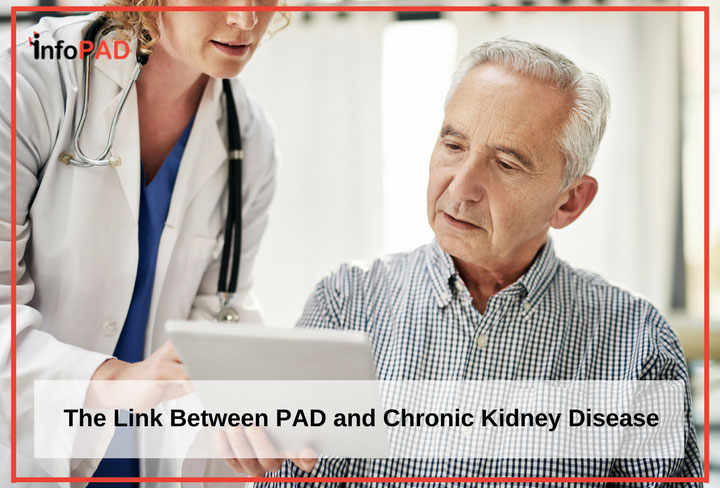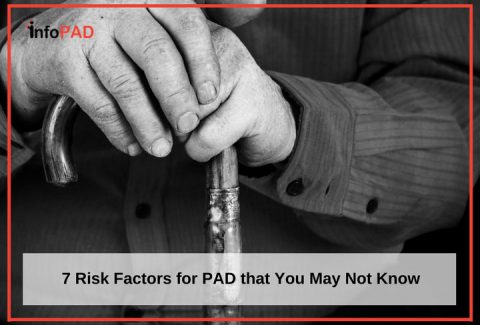
Peripheral artery disease (PAD) is a progressive condition caused by narrowing and blockages of the arteries, usually in your legs. This is most commonly due to atherosclerosis, which is an accumulation of plaque on the inner walls of the artery.i There is another condition, chronic kidney disease (CKD), that contributes to atherosclerosis.ii
There is evidence that CKD patients are at an increased risk of developing cardiovascular diseases, including atherosclerosis. It has become more apparent that there could be a link between these two diseases in the form of an increased risk. However, until recent years, there was little research on this possible connection.
PAD is characterized by reduced blood flow to the extremities, particularly the legs. This decreased blood supply causes wounds to heal slowly or not at all. This allows infections, like gangrene, to take root and can ultimately result in amputation. CKD has many causes, but is characterized by reduced kidney function.
Thanks to the efforts of several teams of researchers, there is now good evidence that there’s likely a link between CKD and PAD. Specifically, it appears that patients with CKD have an increased risk of developing PAD. Let’s take a look at a couple studies supporting this conclusion.
Studies Linking PAD to CKD
A study published in 2005 that was a collaboration between researchers from Johns Hopkins, Duke University and the University of Minnesota looked at more than 14,000 patients over an average of about 13 years. During this time:
- Just over 1,000 of those patients developed CKD
- The patients with CKD developed PAD at a rate of roughly twice that of those without CKD
- This remained true even when the researchers adjusted for the presence of cardiovascular disease
Therefore, the researchers concluded with confidence that their study demonstrates persons with CKD have an increased risk for PAD.iii
Researchers at the Cleveland Clinic addressed the following questions: How does having both CKD and PAD affect the outlook for patients? As you may guess, having these two diseases together appears to increase the risk of mortality. They looked at the mortality rate of 284 patients over a six-year period. They found that:
- Patients with PAD alone had a mortality rate of 26 percent
- Patients with only CKD had a mortality rate of 28 percent
- Patients with neither disease had a mortality rate of 18 percent
- Patients who had both CKD and PAD suffered a mortality rate of 45 percenti,iv
These results demonstrate that CKD and PAD combined can shorten lifespan at a greater rate than either disease alone.
Measures to Take
Early detection and treatment of PAD is vital for the best outcomes. It’s imperative that patients avoid infections and do everything possible to avoid the need for amputation. However, since about half of all PAD patients have no apparent symptoms, it can be very difficult to know if someone has the disease.i
PAD TESTING: Now that research has established a likely link between CKD and PAD, patients have knowledge of an additional PAD risk factor. Specifically, patients who have chronic kidney disease should undergo evaluation for PAD, even if they show no symptoms of the disease.
RELATED: 8 Ways to Tell if You Are At Risk for Peripheral Artery Disease
HEALTHCARE TEAM: Additionally, doctors recommended in a 2015 paper that PAD-CKD patients be managed by a multidisciplinary team. That is, patients with both of these diseases should have healthcare providers from several specialties working in cooperation on their care. These specialities should include vascular specialists, nephrologists (kidney experts) and wound care specialists.v
As a patient, you play a crucial role in your own healthcare. Be sure to adhere to a healthy diet, avoid smoking and excessive alcohol and get plenty of exercise. Also, always be on the watch for symptoms of PAD. If you have CKD, get checked for PAD – even if you aren’t experiencing any PAD symptoms. And always follow the advice of your healthcare providers and take any medications as prescribed. Finally, keep your entire healthcare team up to date on your health history, including your current medications and any new or changing symptoms.
Sources:
i Johns Hopkins. Peripheral Vascular Disease. http://www.hopkinsmedicine.org/healthlibrary/conditions/cardiovascular_diseases/peripheral_vascular_disease_85,P00236/ (accessed 5/29/2017)
ii O’Hare, A.M. “Peripheral artery disease in chronic kidney disease.” UpToDate. http://www.uptodate.com/contents/peripheral-artery-disease-in-chronic-kidney-disease (updated 5/31/2016, accessed 5/29/2017)
iii Wattanakit, K., Folsom, A.R., Selvin, E., Coresh, J., Hirsch, A.T., Weatherly, B.D. “Kidney Function and Risk of Peripheral Arterial Disease: Results from the Atherosclerosis Risk in Communities (ARIC) Study.” JASN, 2006. 18(2): p.629-36. http://jasn.asnjournals.org/content/18/2/629.full
iv Liew, Y.P., Bartholomew, J.R., Demirjian, S., Michaels, J., Schreiber, M.J. “Combined Effect of Chronic Kidney
Disease and Peripheral Arterial Disease on All-Cause Mortality in a High-Risk Population.” CJASN, 2008. 3(4): p. 1084-1089.https://www.ncbi.nlm.nih.gov/pmc/articles/PMC2440260/
v Garimella, P.S., Hirsch, A.T. “Peripheral Artery Disease and Chronic Kidney Disease: Clinical Synergy to Improve Outcomes.” Adv. Chronic Kidney Dis., 2014. 21(6): p. 460-471


